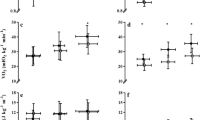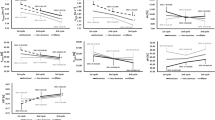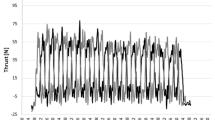Abstract
The propelling efficiency of the arm stroke (η P) was estimated in a group of 63 male and female subjects (9–59 years of age) of good technical skill, swimming the front crawl at sub-maximal speeds. η P was calculated on the basis of values of speed (v), stroke frequency (SF) and shoulder-to-hand distance (l, calculated from measures of arm length and elbow angle during the in-sweep) as proposed by Zamparo et al. (Eur J Appl Physiol 94:134–144, 2005). In both genders, the distance covered per stroke (Ds = v/SF) is similar before puberty, reaches its maximum at about 20 years of age and then steadily declines. l is significantly larger in males than in females and this difference tended to offset the differences in Ds so that η P is almost the same in male and female swimmers of the same age group and swimming ability: about 0.31 before puberty, 0.38–0.40 at about 20 years of age and about 0.25 in swimmers older than 40 years of age. The development of η P and Ds during the life span is similar to the changes in muscle strength and power reported in the literature suggesting that these parameters are related to the ability to exert forceful (and hence effective) strokes in water. Since the energy cost of swimming (C) depends essentially on η P and the hydrodynamic resistance (W d), these data further suggest that differences in C between genders are mainly to be attributed to differences in W d, whereas differences across ages can be attributed also to changes in η P.




Similar content being viewed by others
References
Alexander R McN (1983) Motion in fluids. In: Animal mechanics. Blackwell Scientific Publications, Oxford, pp 183–233
Astrand PO, Rodahl K, Dahl HA, Stromme SB (2003) Textbook of work physiology, 4th edn. Human Kinetics, Champaign, pp 226–269
Berger MA, Hollander PA, De Groot G (1997) Technique and energy losses in front crawl swimming. Med Sci Sports Exerc 29:1491–1498
Kjendlie PL, Ingjer F, Madsen O, Stallman RK, Gunderson JS (2004a) Differences in the energy cost between children and adults during font crawl swimming. Eur J Appl Physiol 91:473–480
Kjendlie PL, Stallman RK, Gunderson JS (2004b) Adults have lower stroke rate during sub maximal front crawl swimming than children. Eur J Appl Physiol 91:649–655
Lavoie JM, Montpetit R (1986) Applied physiology of swimming. Sports Med 165:165–189
Margaria R, Aghemo P, Rovelli E (1966) Measurement of muscular power (anaerobic) in man. J Appl Physiol 21:1662–1664
Montpetit R, Cazorla G. Lavoje JM (1988) Energy expenditure during front crawl swimming: a comparison between males and females. In: Ungherechts BE, Wilke K, Reischle K (eds) Swimming science V. Human Kinetics, Champaign, pp 229–236
Nickleberry BL, Brooks GA (1996) No effect of cycling experience on leg cycle ergometer efficiency. Med Sci Sports Exerc 28:1396–1401
Payton CJ, Bartlett RM, Baltzopulos V, Coombs R (1999) Upper extremity kinematics and body roll during preferred-side breathing and breath holding front crawl swimming. J Sport Sci 17:689–696
Pendergast DR, di Prampero PE, Craig AB, Wilson D, Rennie W (1977) Quantitative analysis of front crawl in men and women. J Appl Physiol 43:475–479
Pendergast DR, Zamparo P, di Prampero PE, Mollendorf J, Capelli C, Cerretelli P, Termin A, Craig A, Bushnell D, Paschke D (2003) Energy balance of human locomotion in water. Eur J Appl Physiol 90:377–386
Pelayo P, Wille F, Sidney M, Berthoin S, Lavoie JM (1997) Swimming performance and stroking parameters in non skilled grammar school pupils: relation with age, gender and some anthropometric characteristics. J Sports Med Phys Fitness 37:187–193
di Prampero PE (1986) The energy cost of human locomotion on land and in water. Int J Sports Med 7:55–72
Tanaka H, Seals DR (1997) Age and gender interactions in physiological functional capacity: insight from swimming performance. J Appl Physiol 82:846–851
Toussaint HM (1990) Differences in propelling efficiency between competitive and triathlon swimmers. Med Sci Sports Exerc 22:409–415
Toussaint HM, de Looze M, van Rossem B, Leijdekkers M, Dignum H (1990) The effect of growth on drag in young swimmers. Int J Biomech 6:18–28
Toussaint HM, Roos PE, Kolmogorow S (2005) The determination of drag in front crawl swimming. J Biomech 37:1655–1663
Vorontsov A, Binevsky D (2003) Swimming speed, stroke rate and stroke length during maximal 100 m freestyle of boys 11–16 years of age. In: Chatard JC (ed) Biomechanics and medicine in swimming IX. Publications de l’Université de Saint Etienne, Saint Etienne, pp 195–200
Wilson B, Thorp R (2003) Active drag in swimming. In: Chatard JC (ed) Biomechanics and medicine in swimming IX. Publications de l’Université de Saint Etienne, Saint Etienne, pp 15–20
Zamparo P, Antonutto G, Capelli C, Francescato MP, Girardis M, Sangoi R, Soule RG, Pendergast DR (1996) Effects of body size, body density, gender and growth on underwater torque. Scand J Med Sci Sports 6:273–280
Zamparo P, Capelli C, Cautero M, Di Nino A (2000) Energy cost of front crawl swimming at supramaximal speeds and underwater torque in young swimmers. Eur J Appl Physiol 83:487–491
Zamparo P, Pendergast DR, Termin B, Minetti AM (2002) How fins affect the economy and efficiency of human swimming. J Exp Biol 205:2665–2676
Zamparo P, Pendergast DR, Mollendorf J, Termin B, Minetti AM (2005) An energy balance of front crawl. Eur J Appl Physiol 94:134–144
Acknowledgements
The technical assistance of Marta Durì, Francesco Grazzina, Laura Pezzutti and Daniele Samar is gratefully acknowledged. I would also like to thank Carlo Lesa (Unione Nuoto Friuli) and all the swimmers for their patience and kind cooperation.
Author information
Authors and Affiliations
Corresponding author
Rights and permissions
About this article
Cite this article
Zamparo, P. Effects of age and gender on the propelling efficiency of the arm stroke. Eur J Appl Physiol 97, 52–58 (2006). https://doi.org/10.1007/s00421-006-0133-9
Accepted:
Published:
Issue Date:
DOI: https://doi.org/10.1007/s00421-006-0133-9




